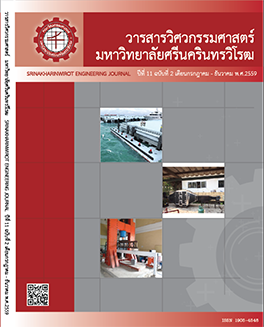วิเคราะห์ปัจจัยที่มีความสัมพันธ์ต่อพฤติกรรมการขับขี่ยานพาหนะย้อนศร: กรณีศึกษาจังหวัดนครนายก
Abstract
บทคัดย่อ บทความนี้แสดงผลการศึกษาปัจจัยที่มีผลกระทบต่อพฤติกรรมการทำผิดกฎจราจร กรณีขับขี่ยานพาหนะย้อนศรในเขตจังหวัดนครนายก จากการสำรวจข้อมูลด้วยแบบสอบถามโดยการสุ่ม จำนวน 424 ตัวอย่าง การทดสอบสมมติฐานทางสถิติด้วยสถิติทีและวิเคราะห์ความแปรปรวนทางเดียว โดยกำหนดตัวแปรอิสระ คือ เพศ อายุ การศึกษา อาชีพ การมีใบอนุญาตขับขี่ และยานพาหนะที่ใช้บ่อยที่สุด ส่วนตัวแปรตาม คือ พฤติกรรมการขับขี่ยานพาหนะย้อนศร พบว่า กลุ่มที่มีระดับความถี่ในการขับขี่ยานพาหนะย้อนศรมากกว่ากลุ่มอื่น อย่างมีนัยสำคัญทางสถิติที่ระดับ 0.05 คือ ผู้ที่มีเพศชาย ผู้มีอายุไม่เกิน 20 ปี และผู้มีอายุมากกว่า 20 ปี แต่ไม่เกิน 30 ปี ผู้ที่กำลังเรียนในระดับมัธยมศึกษาหรือระดับอาชีวศึกษา ผู้ที่มีอาชีพนักเรียนหรือนักศึกษา ผู้ที่ไม่มีใบอนุญาตขับขี่ และผู้ที่ขี่รถจักรยานยนต์ ผลวิเคราะห์ข้อมูลในส่วนของผู้ที่มีพฤติกรรมขับขี่ยานพาหนะย้อนศร จำนวน 313 ตัวอย่าง พบว่า ปัจจัยที่มีผลต่อการลดพฤติกรรมการขับขี่ยานพาหนะย้อนศรมากที่สุด คือ การบังคับใช้กฎหมาย และพบว่าเมื่อระยะทางที่ต้องขับขี่ยานพาหนะย้อนศรเพิ่มขึ้น พฤติกรรมการขับขี่ยานพาหนะย้อนศรลดลง ซึ่งเป็นข้อมูลสำคัญในการกำหนดตำแหน่งจุดกลับรถเพื่อลดพฤติกรรมการขับขี่ยานพาหนะย้อนศร คำสำคัญ: กฎจราจร พฤติกรรม ขับขี่ยานพาหนะย้อนศร นครนายก ABSTRACT This article presents the study results of the influencing factors for illegal traffic practice behaviors specifically for driving in reverse traffic direction in Nakhonnayok province. Information for this study was collected using questionnaires on 424 random samples. The t-Test statistical analysis method and one-way ANOVA were used to analyze the hypothesis. Independent variables were specified as being the age, gender, education level, occupation, holding a valid driving license and most frequently used vehicle. The dependent variable was reverse traffic driving practice. It was found that the group with high frequency of driving in reverse traffic at a significant level of 0.5 point are male, aged below 20 and those who are over 20 but no more than 30 years old, studying in high school or vocational school, going to school or university, do not have a valid driving license and those driving motorbikes. Information analysis of the 313 samples with the reverse traffic driving behavior indicated that the most influential factor that would reduce this behavior is law enforcement. It also found that if the distance to the destination in reverse traffic increased then the practice will decrease. This finding is significant in identifying the U-turn positions that will decrease the reverse traffic driving behavior. Keyword: Traffic Rules, Behavior, Driving Against Traffic Flow, NakhonnayokDownloads
Download data is not yet available.
Downloads
Published
2017-01-04
Issue
Section
บทความวิชาการ
License
ลิขสิทธิ์เป็นของวารสารวิศวกรรมศาสตร์ มหาวิทยาลัยศรีนครินทรวิโรฒ





